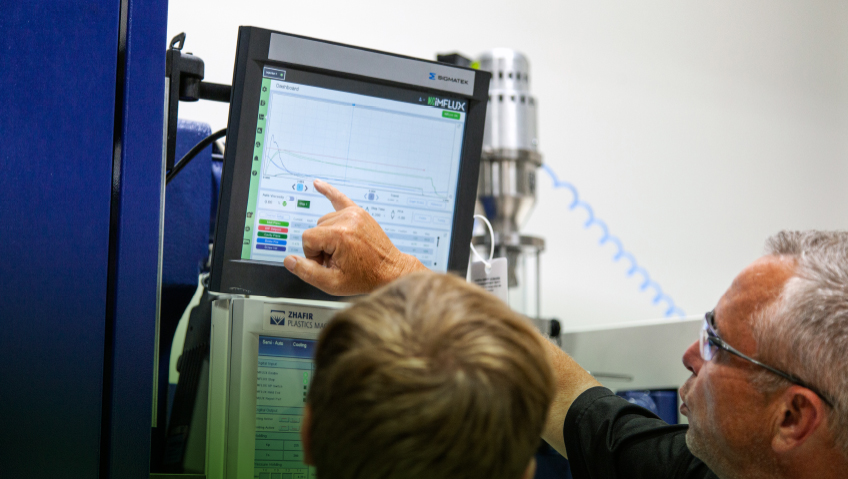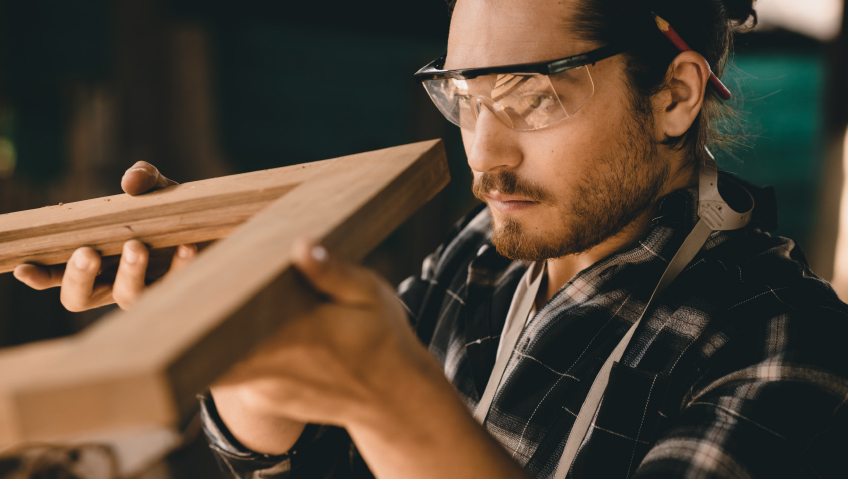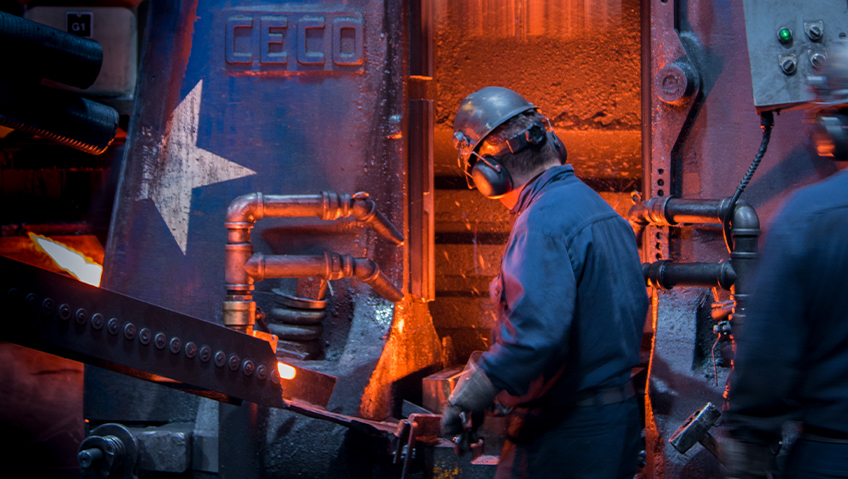In the manufacturing sector, a new technology comes along every few years that genuinely turns the industry on its head. In this case, the company leading the way in transforming the future of plastic injection molding is iMFLUX, Inc.
A wholly-owned subsidiary of American consumer goods multinational Procter & Gamble, iMFLUX’s origins go back to 2013 when P&G incorporated a separate entity to meet the injection molding needs of the company and some strategic partners. Within a few years, iMFLUX became known as a game-changer in the molding industry.
“iMFLUX takes the way conventional injection molding has been done and flips it on its head,” says Chief Technology Officer Gene Altonen. “We do the opposite of what the industry has been taught for the last 30 years of how to process plastics.”
Instead of injecting fast at high pressures and very high shear rates – which is how molding is done conventionally – iMFLUX injects at slow fill rates, and lower pressures. Changing the approach can have multiple benefits including higher quality parts, reduced cost and cycle time, improved process reliability and the ability to incorporate more sustainable materials. The capability to process with iMFLUX technology can be built into new injection molding machine designs or can be fit to virtually any existing press on the market.
Taking on an industry
Before joining P&G in 1990, Altonen was a student at Michigan State University, later to be recruited by the company. In packaging development for about a decade, he began to focus on injection molding, ultimately moving into upstream injection-molding development and vetting technologies developed by external companies.
Spending 20 years specializing in injection molding and evaluating and developing technologies, Altonen is known as not only one of the inventors of the revolutionary iMFLUX technology but also as someone behind most of the company’s 200-plus global patents.
“iMFLUX is an adaptive technology,” he says of the company’s work, explained on its own YouTube channel at https://www.youtube.com/channel/UCaTXj9qQTM666PJdhIjJSLQ. “We have the ability to react to what is occurring in a mold in real time. We can compensate for it, and make intelligent decisions on behalf of an operator so they can keep the machine running, even when there might be a lot of instability in the mold itself, or the material, or the machine,” explains Altonen.
“And so that adaptive nature of our technology is also a very fertile ground for patent applications as well. Between those two – the basics of our technology works, and then these adaptive characteristics of our technology – that’s really how we’ve been able to build such a large patent portfolio in only about 10 years.”
Delivering innovation
With an extensive background in manufacturing, sourcing, supply chain management, and the innovation space, Mary Wagner was the ideal choice to become Chief Executive Officer of iMFLUX. A veteran Procter & Gamble employee, Wagner previously led Purchases and Product Supply organizations in the U.S. and China, most recently leading the company’s global Packaging Purchases organization.
With a wealth of technical and business education – much of it based on driving innovation, developing external partnerships, and creating ecosystems for P&G – Wagner has worked with numerous injection molding companies and has used those experiences to help create the iMFLUX business model.
“I think a combination of technical, business, and supply chain background is what they were looking for me to leverage with iMFLUX, and take it from a technology start-up to something you scale as a business,” she says.
Coming on board in 2018, Mary Wagner’s role has been to take the company from start-up to scale, to build partnerships, and to look at ways to take fresh innovations and build them out within the injection molding ecosystem and industry.
When new customers come in asking about the technology, Wagner and Altonen say they often use the term “adaptive driving,” metaphorically likening iMFLUX to today’s autonomous vehicles, which use state-of-the-art devices to keep them safely on the road.
Years ago, cruise control to ensure cars were kept to a constant speed was considered revolutionary. Today, technology has advanced to where car wheels vibrate slightly if a driver has left the lane, while sensors automatically trigger the brakes if the vehicle detects something in its path and a likely collision.
Just as this technology is adaptive to help improve driving performance, a similar comparison can be made to iMFLUX and molding.
“We think of an injection molding machine, and how it’s controlled through a very similar lens,” says Altonen, explaining that in an injection molding operation the machine, materials and molding environment vary. With iMFLUX, the machine adjusts itself to compensate for variations in the molding environment.
“The way our processing technology works is that it’s able to sense and detect those changes as they occur, and it’s able to make corrections to the process to compensate for those changes as they occur to make sure you make good parts.”
This means machines run more reliably with fewer operator adjustments, resulting in higher-quality parts, reduced costs, and lower capital – all while advancing sustainability efforts such as using less energy and reducing waste.
Along with saving customers time, money, energy costs, and more, iMFLUX addresses another key issue facing manufacturing today, namely labor shortages.
With thousands of experienced workers retiring every day and insufficient job applicants to take their place, industry in general needs new and innovative ways to address the worker shortfall. Since iMFLUX’s unique technology is easy to run and can improve reliability, it is fast gaining popularity with businesses.
“In a world where sustainability is increasingly more important to the plastics industry, a machine that adapts when you run recycled resins and re-grind is super-attractive,” says Wagner. “Between the challenges associated with productivity, labor, and sustainability, iMFLUX offers a solution that addresses many day-to-day molding challenges.”
The Green Curve™
In recent months, one of the biggest reasons customers are coming to iMFLUX is the push for sustainable solutions. Enter The Green Curve – a better, and different, way to mold.
Excited about the benefits of the Green Curve, the company has recently released a video explaining the process at https://www.imflux.com/the-green-curve-video/. With many advantages, the technology enables companies to be more productive, produce products with better quality, have greater material and design flexibility, and address sustainability solutions through faster cycle times, less scrap, and more consistent quality.
Clients can save on material costs, and this technology allows designers more freedom in creating plastic parts.
Whereas conventional molding processes use a combination of high-pressure/high shear and are static, The Green Curve approaches processing differently.
Value, every which way
A pressure sensor is added to machines, which is used as a primary control signal for the entire process. This causes the machine to regulate pressure to achieve a desired pressure setpoint, which is maintained consistently throughout the entire filling of the mold cavity. As a result, pressure is much lower – sometimes by as much as half – with a slower filling of the mold. Cycle times are shorter by 5 to 25 percent or more because cooling time can often be reduced when the part packs as it fills.
Companies can apply this technology to many applications. “It doesn’t do them any good if it only works on one or two of their lines if they have 100 lines. They need a solution that works on all of their lines,” says Altonen. “iMFLUX does that. It works on any machine type, new or used. It can be applied broadly across your business. Companies want solutions that add value and do not have trade-offs. A lot of the solutions out there have trade-offs.”
Through iMFLUX, molders can utilize a wide spectrum of post-consumer recycled materials – which are highly variable in their viscosity – to make consistent parts. And as less energy is required, the carbon footprint is reduced.
Since iMFLUX runs processes with lower shear and typically lower temperatures, it is gentler on different materials – even compostable, degradable, and marine-degradable materials, all of which are sensitive to shear and heat.
And since the technology is low pressure, it can be used to design parts that are lighter and thinner than ever.
“With conventional processing, you can only go so thin before your pressures become unmanageable and become very high,” says Altonen. “With iMFLUX, because you’re working with lower pressures, you can make those parts thinner, lighter, and keep your molding pressures very manageable.” This includes parts weighing from tenths of a gram (micro-moulding) to 50 pounds.
Working with a broad range of industries including consumer products, automotive, medical, electronics, and logistics, iMFLUX technology works on virtually any machine or mold to produce plastic parts of all sizes. As the company matures, it is seeing growth in the automotive and medical sectors, and those interested in sustainability.
“Many companies are using higher levels of post-consumer recycled materials but run into processing limitations,” says Wagner. “Those types of companies find great value in iMFLUX because it offers them a sustainability solution at scale.”
In the future, iMFLUX wants to see manual steps, such as qualifying a new mold, performed automatically, with the machine itself identifying the optimal processing window for the operator. The theme of this innovation pipeline, says Altonen, is what the company calls its journey to autonomous molding.
“Our most recent innovation in that space is what we call Auto Viscosity Adjust,” he says of the feature, which can compensate for variations and allow molding machines to make good parts with no need for an operator to continuously monitor and tweak.
Changing the way the world molds
Ultimately, iMFLUX is low-pressure, adaptive technology. More than a simpler way to mold, it enables molders to achieve results that are absolutely not possible in today’s non-iMFLUX injection molding world. This new technology’s flexibility and ability to work on any machine, material or mold is attractive to customers looking for unique solutions.
“Most molders have more than one brand of machine on their floor, so technology that works with the multiple machine partners they have is attractive,” says Wagner. “We want to change the way the world molds, and we believe iMFLUX offers a better way to do it. iMFLUX brings value, and we invite people to join with us on this journey to autonomous molding.”






